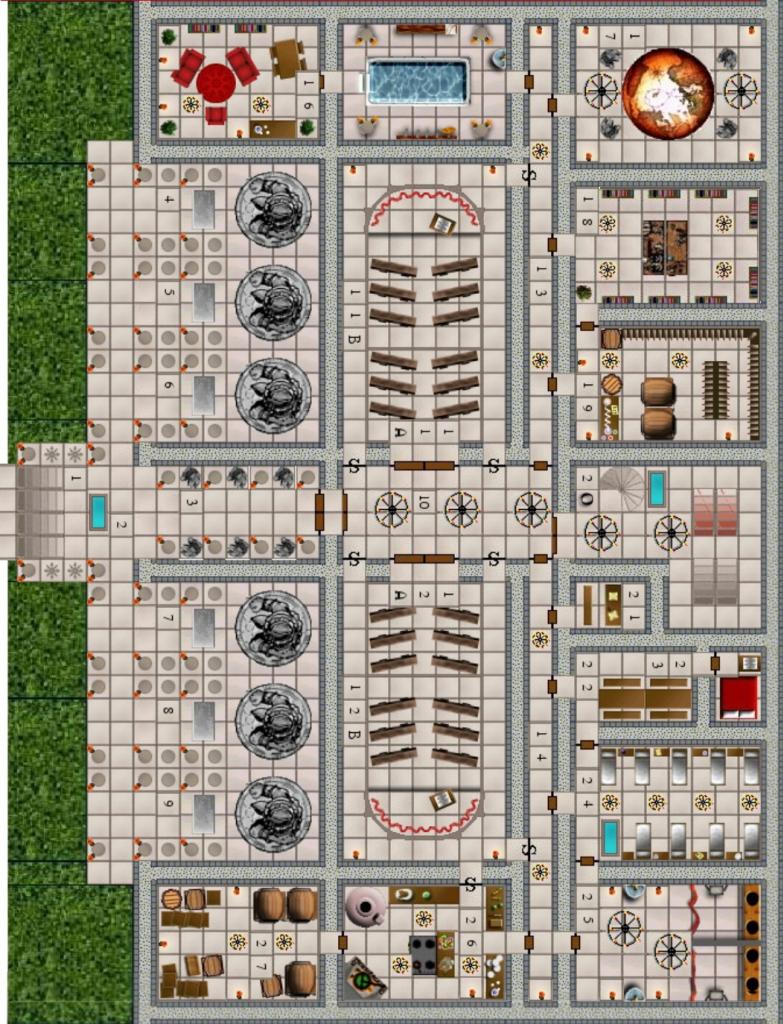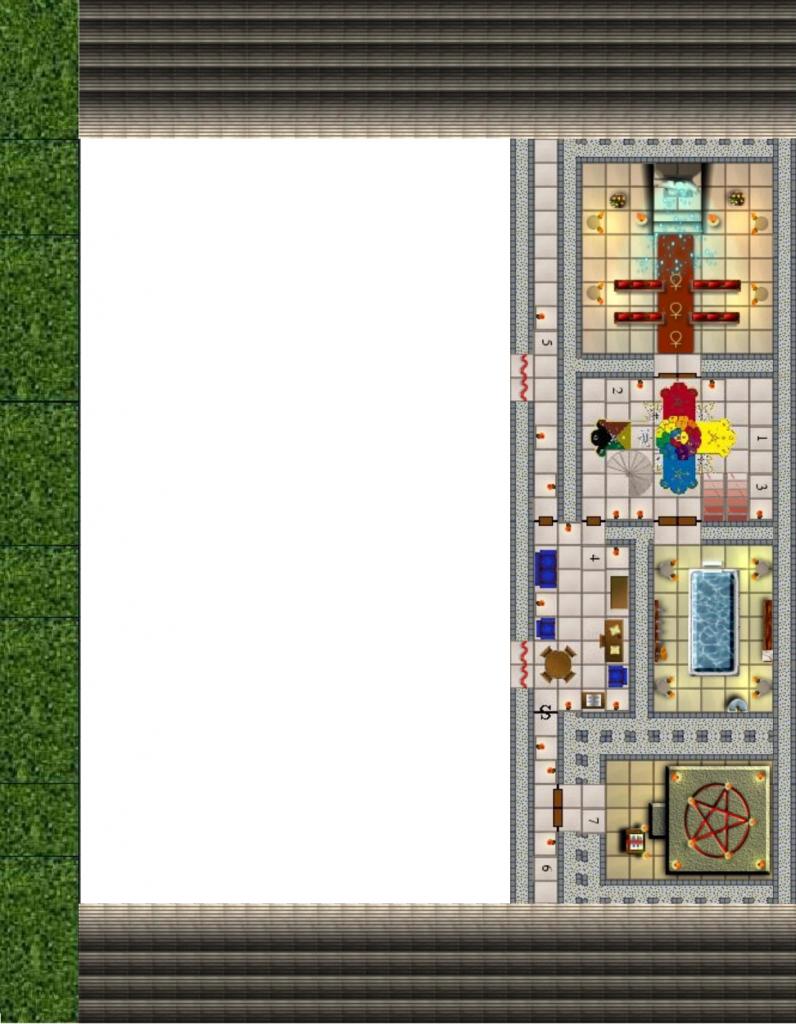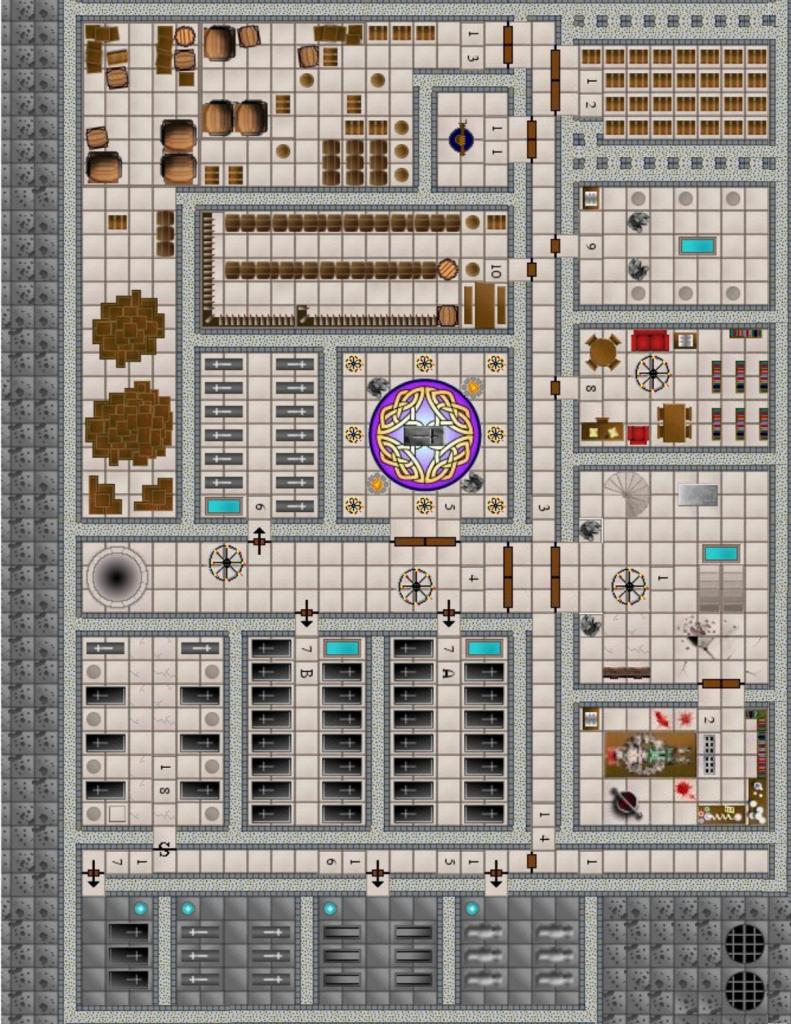
The Melinir Temple
by Chris SeabrookThe Temple, at two stories at it's edges, and three stories at it's peak, is one of the tallest buildings in Melinir. The temple is partially a Hellenistic temple with publicly viewable statues of immortals for personal communion, donation, or sacrifice), part church (for community worship or meetings on the holy days of a respective immortal), part shelter for the poor, part hospital, part funeral home, part medicine/ potion/ holy water factory, and part monastery.
Here is the original write-up about the Melinir temple:
14. Temple
The trails through the temple complex run through peaceful groves of tress, creating a feeling of relaxation and meditative silence. The temple itself is a large, open building. Tall windows let sunlight flow into the chapel.
The cleric in charge of maintaining the temple is Martin, rotund fellow. He is a friendly man, always ready to help a person in need. Since the temple receives everything through charity, there is no charge for the services of the clerics.Collin, McComb. Thunder Rift. 1. Lake Geneva, Wisconsin, USA: TSR, 1992. 32. Print.
This temple (that I designed) was definitely set up to be in Darokin. The hallway in is lined with statues that where the "Twelve Watchers" (see: Darokin Gazetteer, the Gold Box, and Wrath of the Immortals- Codex of the Immortals). The rest of the statues out front where of other Darokin immortals. Despite this, it should be possible to re-purpose it.
Here are some good sources on religion in Darokin:
Gaz 11: The Republic of Darokin
Faiths of Darokin
Immortals and Churches in Darokin
The Church of Darokin
Faith and Worship in the Republic of Darokin or here
Since the temple has to perform the burial ceremonies, any necessary embalming, and is the only institution capable of dealing with disease, lycanthropy, and undeath, the priests are stuck dealing with all maters relating to death. This, in addition to their custodianship of the library and archive, and their abilities of divination, places them in the role of forensic investigators, and detectives (I was thinking of a fighting cleric version of Brother Cadfael
Melinir Temple- 1st Floor:

Melinir Temple- 1st Floor:
Entry
1: Entry ramp
2: Water basin for purification; sometimes filed with holy water.
Public Temples to the Darokin Immortals
3: Entry passage with the Twelve Watchers. Two stories with arched ceiling. Walls covered in frescos detailing the mythology of the Twelve Watchers and ceiling painted with scenes from Darokin Immortal mythology. The Twelve Watchers are a group of major figures in the Darokin pantheon. Each of the Twelve is a patron of a different Craft of some sort, and each is known by the name of the craft his is a patron of (Carpenter, Smith, Miner, Butcher, Farmer, etc.). The Watchers are the major patrons of the "common" folk of Darokin.
4: Shrine to Petra. Two stories with a barrel vault ceiling. Surrounded by Doric pillars and ceiling painted with scenes detailing the mythology of Petra. Contains a statue of Petra and an alter for prayers and conducting ceremonies, and sacrifices. Petra, the patron of cities and defenders, has long had a steady following in Darokin. As a protector of cities, her following also grew during the war. Now, her priests are spreading her word even farther, and are using the destruction caused by the war to call out for improvements to the cities and the city defences. Petra is a favourite patron of watchmen and city guards.
5: Shrine to Halav. Two stories with a barrel vault ceiling. Surrounded by Doric pillars and ceiling painted with scenes detailing the mythology of Halav. Contains a statue of Halav and an alter for prayers and conducting ceremonies, and sacrifices. Halav, patron of weapon smiths and warriors, has a small following in Darokin. He is mainly worshipped among smiths and weapon smiths, though he shares this following with the Watcher Smith. Halav's faith is growing in Darokin, however, with tensions rising on the western border.
6: Shrine to Solarios (Ixion). Two stories with a barrel vault ceiling. Surrounded by Doric pillars and ceiling painted with scenes detailing the mythology of Solarios. Contains a statue of Solarios and an alter for prayers and conducting ceremonies, and sacrifices. Solarios, Immortal patron of the sun, is another member of the Darokin pantheon. Solarios's following is not as strong in Darokin as it is in Thyatis, but he still has a large number of followers. Solarios embodies everything about the sun - fire, strength, and light.
7: Shrine to Asterius. Two stories with a barrel vault ceiling. Surrounded by Doric pillars and ceiling painted with scenes detailing the mythology of Asterius. Contains a statue of Asterius and an alter for prayers and conducting ceremonies, and sacrifices. The leader of the Darokinian pantheon is Asterius, patron of Commerce and Diplomacy. Asterius is popular among the merchant class of the nation, who know that promoting diplomacy with other nations is good for business.
8: Shrine to Koryis. Two stories with a barrel vault ceiling. Surrounded by Doric pillars and ceiling painted with scenes detailing the mythology of Koryis. Contains a statue of Koryis and an alter for prayers and conducting ceremonies, and sacrifices. Patron of Peace. Like Asterius, Koryis encourages his followers to use diplomacy to work out differences instead of the sword.
9: Shrine to Kagyar. Two stories with a barrel vault ceiling. Surrounded by Doric pillars and ceiling painted with scenes detailing the mythology of Kagyar. Contains a statue of Kagyar and an alter for prayers and conducting ceremonies, and sacrifices. Kagyar the Artisan is another member of the Darokin pantheon. A patron of artists and art, Kagyar's priests encourages his followers to respect and patronize art as much as possible. Kagyar is a favourite of artists.
Public Hall
10: Central Hall and Community Social Hall. Vaulted ceiling with three large chandeliers. Two Stories with arched ceiling. Walls covered with frescoes of Thunder Rift and Darokin history,
Chapels and Congregation Halls
11: First Chapel: Two Stories with arched ceiling
A:Public area with benches, raised dais, and podium. Walls covered with frescoes of Thunder Rift and Darokin mythology.
B: Secret backstage area with secret doors.
12: Second Chapel: Two Stories with arched ceiling
A:Public area with benches, raised dais, and podium. Walls covered with frescoes of Thunder Rift and Darokin mythology.
B: Secret backstage area with secret doors.
Corridors
13: North corridor. One story with unadorned walls. One torch holder in the northern corner, and two small chandeliers.
14: South corridor. One story with unadorned walls. One torch holder in the southern corner, and two small chandeliers.
Holy Water Blessing (Holy Water Factory) and Storage Pool
15: Holy water pool. In the northwest corner is a small basin with running water for sanitation, on the north wall is a bench, and on the south is a rack of bottles of holy water for sale. The room is lighted by torches attached two the four pillars that occupy the corners of the room. The pool is used for the production and distribution of holy water. In extreme cases, certain victims may be immersed or bathed in the pool for redemption, purification, or resurrection.
Comfortably Furnished Room
16: Grieving, Delicate Matters Discussion and Study/ Relaxation Room. This room also functions as: temple library, research room, office, and a private prayer and meditation room. This room has two tables; one square of polished wood, and one round of polished wood with a red cover. Around the square table are four chairs of polished wood. Around the round table are two overstuffed couches and one stuffed chair of the same red as the table. On the north wall, are two bookcases. Along the east end of the south wall is a wooden desk. There are three potted aromatic shrubs in every corner but the northeast corner. Three torches and two small chandeliers light the room. The priests either use this room for study and relaxation, or whenever a comfortable room is needed (such as when comforting a grieving family, or assigning a quest).
Globe room.
17: Prayer, Scrying, Divination and Meeting Room. This room is lighted by four torches or the two large chandeliers. There are four statues of the fist Quadrial surrounding a magical globe. The globe has been used by the immortals to send omens and auguries about important international events. (Such as storms, invading armies, or natural disasters). The globe can be used for divination purposes when a priest needs information about a far-off area.
Herbalist/Alchemist/Chemist’s lab.
18: Medicine, potion, magic item, charm, and spell preparation room (and surgery room if needed). The centre of this room is filled with a huge worktable covered in a myriad of spilled substances, herbs, minerals, alchemical apparatuses, crucibles, bottles, and books. In front of a door in the southeastern corner, is a potted herb that looks mostly picked. The walls are lined with shelves of books, bottles, fresh and dried herbs, and animal parts. The room is lighted by four small chandeliers. This room is used for the preparation of different potions for sale and distribution to those important parishioners who need them. Sometime, the alchemist’s lab is used for preparing spell components of visiting mages, or as an extension of the bottlery, or kitchen.
Distillery and Bottlery
19: Bottlery. This room has a table covered with devices used for the sterilization of bottles, the corking of bottles, and the preparation of potions. In the room is are two large kegs, one of ceremonial wine, and the other of either ale or beer. The two small kegs contain either mead, or random liquor. The north and east walls are covered with bottle racks. Three torches or two small chandeliers light the room. This room is used for preparing and bottling holy water, potions, beers, wines, liquors, and spirits made on site. Sometime, the bottlery is used for preparing spell components of visiting mages, or as an extension of the alchemist’s lab, or kitchen.
Stairs
20: Holy Water Basin and Stairs Up and Down. This room has a circular staircase that leads to either the second floor, or the basement/ crypt. Behind the staircase is a basin of holy water for purification. Behind the basin are two ramps split by a small landing; one ramp leads two the basement/ crypt, the other leads upstairs. Two large chandeliers light the room.
Temple Office
21: Office. This room is a small office. It contains one large and obviously intentionally intimidating polished wooden desk, one long wooden bench in front of a desk, and a small padded wooden chair behind the desk. A small chandelier lights the room.
Dining Room
22: Infirmary dining room. This room has one long rough wooden table, and four polished wood benches. This room is lit by one large overhead chandelier. This room is used for feeding infirmary patients, and the occasional clergy member who doesn’t have time to return to their private building.
Special infirmary.
23: Rented Room. The room contains one double feathered bed, and a small shelf/ desk. The room is lit by a single candle. This small room is for the inhabitation for treatment purposes of the either the wealthy, important, or special friend of the church who is in need of special care.
Hostel and Infirmary with Holy Water Basin
24: General infirmary. This room contains nine small wooden beds with thin straw mattresses, eight small shelves between the beds, and a basin of holy water. The room is lit by four small chandeliers. This room is inhabited by the those in need of the churches special attention. This is usually the sick or gravely injured, but also includes the old without anyone to care for them, the disabled, the maimed, and the starving and homeless. Since there is so little room in the infirmary, only those who the church wishes to stay do so, and only then for a short amount of time and a lot of money, if they have any.
Garderobe or Privy
25: Bathroom for Those that Cannot Use the Outhouses. This room has two wash basins with clean running water, one on the north side, and one on the south side. The back quarter of the room is split by a wooden wall. Hiding the two cubicles (one for men, and one for women) are two heavy wool curtains. Each cubicle contains two toilets. The room is lit by two large chandeliers, and four torches (two on either side of the washbasins).
Kitchen
26: Kitchen. this room has two tables on either side of the eastern door, another table lies along northern wall, and another table lies in the centre of the room, up against the stove and oven. In the northwest corner of the room lies a large clay baking oven, in the southwest corner of the room is a hearth with a spit and pot. Three chandeliers light the room. This is where all the food served at either special occasions to the parish, or to those in the infirmary gets produced. Sometime, the kitchen is used for preparing spell components of visiting mages, or as an extension of the alchemist’s lab, or bottlery.
Upper Storage
27: Storage. this room holds numerous barrels, kegs, boxes, chest, sacks, and crates. Everything that needs to stored for only a short time before usage on this floor goes here.
Melinir Temple - 2nd Floor:

Melinir Temple - 2nd Floor:
Mosaic Room with Stairs; Priest's and Paladin's Chapel; Holy Water Blessing Basin and Storage Room; Prayer, Meditation, Meeting Room, Lounge, or Self Preparation Room; Corridor with Public Chapel Viewing Window; Banishment, Exorcism, Curse Removal, and Dangerous Acts Chamber.
Melinir Temple - Basement, Mortuary and Crypts:

Melinir Temple - Basement, Mortuary and Crypts:
Basement Entrance with Holy Water Basin and Bench; Autopsy, Embalming, and Makeup/ Preparation Room; Basement Library Focusing on Obituaries, Will and Testaments, Causes of Death, General Mortality, Preservation Techniques, and Investigating, Creation, and Ways of Dealing with the Undead; Blessing, Last Rights, and Funerary Services Room; Temple Treasury and Accounts, Special Documents, and Valuable Item Storage; Temple Large Storage Room (to Feed the Public in the Event of Attack or Famine), Water Well; Potion, Medicine, Spirits, Wine, and Beer Storage; Crypt of Founder or Hero; Temple Crypts; Secret Doors to Ancient and Frequently Disturbed Burial Chambers; Garderobe or Privy Drainage.